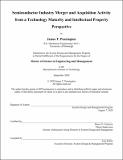| dc.contributor.author | Pennington, James T. | en_US |
| dc.contributor.other | Massachusetts Institute of Technology. Engineering and Management Program. | en_US |
| dc.contributor.other | System Design and Management Program. | en_US |
| dc.date.accessioned | 2021-10-08T16:59:26Z | |
| dc.date.available | 2021-10-08T16:59:26Z | |
| dc.date.copyright | 2020 | en_US |
| dc.date.issued | 2020 | en_US |
| dc.identifier.uri | https://hdl.handle.net/1721.1/132854 | |
| dc.description | Thesis: S.M. in Engineering and Management, Massachusetts Institute of Technology, System Design and Management Program, September, 2020 | en_US |
| dc.description | Cataloged from the official version of thesis. | en_US |
| dc.description | Includes bibliographical references (pages 73-76). | en_US |
| dc.description.abstract | A major method of acquiring the rights to technology is through the procurement of intellectual property (IP), which allow companies to both extend their technological advantage while denying it to others. Public databases such as the United States Patent and Trademark Office (USPTO) track this exchange of technology rights. Thus, IP can be used as a public measure of value accumulation in the form of technology rights. As perceived value increases in the child company, M&A occurs . Extensive bodies of research exist concerning merger and acquisition (M&A) activity. This is likely due to the increasing trend of M&A in the market overall and the trillions of dollars involved. Between 1985 and 2018, US M&A value increased by 5.32% with 2017 US deals alone amounting to $1.7 trillion. These figures demonstrate the increasing importance of M&A. This is especially true in technology-centric industries where prior surveys identify a specific product or technology as the prime motivator for mergers. Understanding the transfer of technology and its value will become important in the future if high-tech industries also follow this increasing trend. This study explores M&A activity within the context of the semiconductor industry by focusing on two parent companies, Intel and AMD, and their child company acquisitions from 1997 to 2017. These acquisitions total more than $53 billion and extend into 35 separate high-tech industries outside the parents' core semiconductor business. In terms of IP as assets, all 91 acquired companies represent 5K in pipeline patent applications and 37K patents. The research suggests that there is a buildup of technological value as measured by the increase of applications and patents by the child company prior to the merger event with the parent (e.g. Intel or AMD). Additional relationships such as child company M&A acquisition value to IP quantities, IP lifespan to child company lifespan, and technology maturity are explored. This study also proposes and implements a TRL (Technology Readiness Level) scale specific to the semiconductor industry and maps it to IP cycle times (USPTO processing times). The application of TRLs to IP data creates an approximate idea as to which maturity of technology is most valuable: new concepts or mature ideas. Results suggest that the child companies seek technology IP with higher TRLs, and these child companies are in turn acquired by the parent company (e.g. Intel or AMD). | en_US |
| dc.description.statementofresponsibility | by James T. Pennington. | en_US |
| dc.format.extent | 98 pages | en_US |
| dc.language.iso | eng | en_US |
| dc.publisher | Massachusetts Institute of Technology | en_US |
| dc.rights | MIT theses may be protected by copyright. Please reuse MIT thesis content according to the MIT Libraries Permissions Policy, which is available through the URL provided. | en_US |
| dc.rights.uri | http://dspace.mit.edu/handle/1721.1/7582 | en_US |
| dc.subject | Engineering and Management Program. | en_US |
| dc.subject | System Design and Management Program. | en_US |
| dc.title | Semiconductor industry merger and acquisition activity from a technology maturity and intellectual property perspective | en_US |
| dc.type | Thesis | en_US |
| dc.description.degree | S.M. in Engineering and Management | en_US |
| dc.contributor.department | Massachusetts Institute of Technology. Engineering and Management Program | en_US |
| dc.identifier.oclc | 1263245162 | en_US |
| dc.description.collection | S.M.inEngineeringandManagement Massachusetts Institute of Technology, System Design and Management Program | en_US |
| dspace.imported | 2021-10-08T16:59:25Z | en_US |
| mit.thesis.degree | Master | en_US |
| mit.thesis.department | SysDes | en_US |
